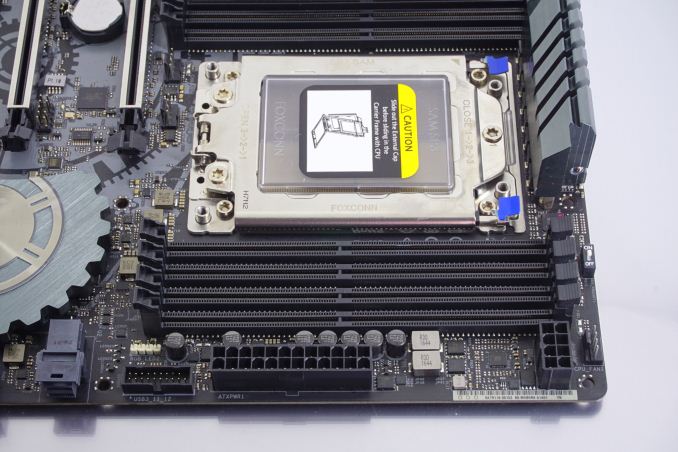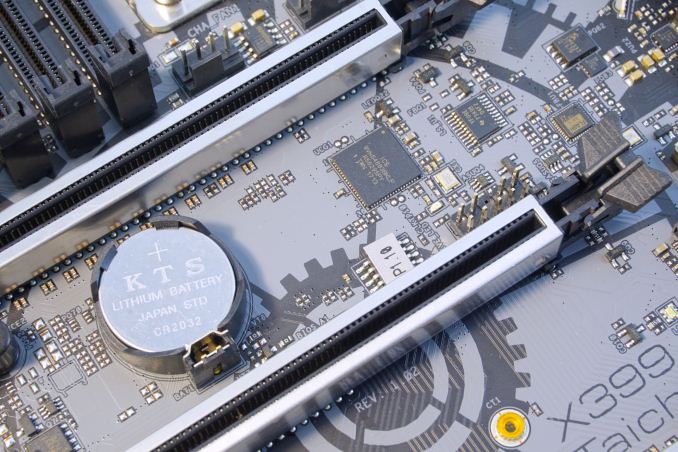The ASRock X399 Taichi Motherboard Review: Cost-Effective Threadripper
by E. Fylladitakis on October 26, 2018 8:00 AM EST- Posted in
- Motherboards
- AMD
- ASRock
- ThreadRipper
- X399
Conclusion
ASRock designed the X399 Taichi to be a product that would appeal to the largest number of users possible, a verity that is also supported by the generic marketing efforts that are not focused on any specific group of users. The motherboard has a wide range of features and competitive pricing, while it retains the capability to support multi-GPU systems. Its design and layout are largely based on the support of multiple graphics cards, with both mechanical and electrical support for powerful cards, as well as the supply of the necessary PCIe bridges for building dual, triple, and quad GPU systems.
For the most part, the ASRock X399 Taichi shares the same features and subsystems with all AMD X399 motherboards currently available. ASMedia supplies the ASM3142 USB 3.1 Gen 2 controller, the Realtek ALC 1220 codec is the heart of the audio system, and Intel provides the two I211-AT NICs. ASRock did not even remove the wireless connectivity features, with 802.11ac Wi-Fi and Bluetooth 4.2 present onboard. In term of storage device ports, the motherboard still has eight SATA ports and three M.2 slots that are exactly what is currently available on other AMD X399 motherboards (or more), plus an extra U.2 port that shares its lanes with a M.2 slot.
Despite the comparatively low price of the motherboard, the ASRock X399 Taichi is not lacking anything in terms of quality or implementation when compared to its more expensive alternatives. The power circuitry is on par with the most expensive AMD X399 motherboards currently available and technically better than that of significantly more expensive implementations. Furthermore, the designer did not cut corners on the application of the major subsystems either, with a fully isolated audio circuitry that also features audio-specific capacitors and a proper headphones amplifier.
The ASRock X399 Taichi also is an aesthetically pleasing motherboard. We feel that the designer did an excellent job creating an interesting and yet subtle aesthetic design. Everything, from the colors to the geometric shapes, are excellently combined to give the ASRock X399 Taichi its distinct appearance. On the other hand, the gear-shaped chipset heatsink is more than just a cosmetic part, as it has greater size and mass than that of most AMD X399 motherboards currently available, allowing for very low operational temperatures.
On performance, the X399 Taichi did well in our power consumption tests at load, but this is due to it having the least aggressive clocking during benchmarks. Almost all benchmarks, except Blender, despite being within a couple of percent of the top performer, the Taichi was at the bottom of the list. Despite this, our overclocking results showed a very easy 4.0 GHz overclock on air, or a flat 3.4 GHz will knock 86W from a stock system.
Combined with a conservative bundle, the company managed to bring the retail price of the motherboard below $300. For the feature set and performance, the Taichi offers very good value.
AnandTech's AMD Ryzen Threadripper and X399 Motherboard Coverage
- The AMD Ryzen Threadripper 1950X and 1920X Review: CPUs on Steroids
- An AMD Threadripper X399 Motherboard Overview
- Analyzing Threadripper Thermals: Big Base Cooling Wins
- The GIGABYTE X399 DESIGNARE EX Motherboard Review
- The ASRock Fatal1ty X399 Professional Gaming
- The ASUS X399 ROG Zenith Extreme Motherboard Review: Top Tier Threadripper
- AMD Reveals Threadripper 2 : Up to 32 Cores, 250W, X399 Refresh
- GIGABYTE’s X399 Aorus Extreme: The Threadripper 2 Halo Motherboard
- MSI's New Threadripper 2 Motherboard on Steroids: X399 Creation
- New EKWB Threadripper X399 Monoblocks for GIGABYTE and MSI












29 Comments
View All Comments
Atari2600 - Friday, October 26, 2018 - link
I have one - very happy with it and would not hesitate to recommend it - but note there are two version of the Threadripper Taichi.The 128GB memory capacity version (X399 Taichi) and a 64GB memory limited one (X399M Taichi), which would be quite a bit cheaper.
If you get the chance to ask ASRock, would be nice to see if the X399M has a performance differential to the X399. i.e. is it a good option to get onto the platform for cheap?
AdditionalPylons - Friday, October 26, 2018 - link
The memory slots (4 vs 8) isn't the only differences. X399 Taichi is ATX, while X399M Taichi is mATX. For example the smaller has one less PCIe x16, only 1 instead of 3 m.2 slots, no PCIe x1 (vs 1 on the larger). These are common tradeoffs with mATX (or to a larger extent mini-ITX). Not that it is a limit for me or many others. I'd still go for mini-ITX next time I build a PC.LeadbyFaith21 - Friday, October 26, 2018 - link
Actually the mATX Taichi still has 3 M.2, the other two are to the right of the RAM slots. I'm also pretty sure it's using the same VRM as the ATX version, so the only "compromise" of it is half the RAM slots and 1 less PCIe x16 slot.kobblestown - Friday, October 26, 2018 - link
This may come as a little pedantic but the X399M has one less PCIe x8 slot. It actually has 1 *more* PCIe x16 slot because it's 3*PCIe x16 whereas its big brother is 2*PCIe x16 + 2*PCIe x8LeadbyFaith21 - Friday, October 26, 2018 - link
Yeah, I forgot about lane allocation difference, I was just thinking full length slots.The_Assimilator - Friday, October 26, 2018 - link
No, there are not "two versions", there is an ATX-format board which is reviewed here, and then there's the mATX X399M. As the different model numbers imply, they are completely different boards.Atari2600 - Friday, October 26, 2018 - link
"two versions of the Threadripper Taichi"What part of that is wrong?
PeachNCream - Friday, October 26, 2018 - link
What do Chinese martial arts, HEDT CPUs, and large metal gears all have in common? Nothing at all! Yet ASRock proves once again that a disjointed mashup rivaling Abe Lincoln: Vampire Hunter by taking a combination so naturally suited to comedy with an altogether too serious fashion can indeed land sales among people inexplicably drawn to such an unusual merger in order to claim ownership over a high core count braggart-box desktop in a world that revolves instead around price-gouging smartphones. Shine on you crazy ASRock diamond. Shine on.rav10101 - Friday, October 26, 2018 - link
Made my day.Agent Smith - Friday, October 26, 2018 - link
Very entertaining post